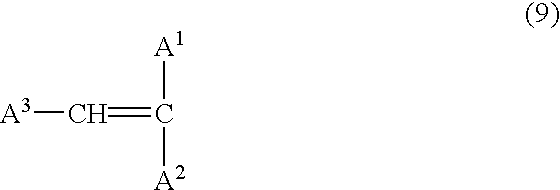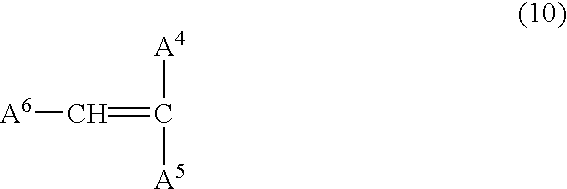Spinning oil for synthetic fiber
a technology of synthetic fiber and spinning oil, which is applied in the field of spinning oil for synthetic fiber, can solve the problems of increasing the incidence of fluff and yarn breaking, increasing the cost of oil, etc., and achieves the effect of long-term stable treatment of false twisting
- Summary
- Abstract
- Description
- Claims
- Application Information
AI Technical Summary
Benefits of technology
Problems solved by technology
Method used
Image
Examples
examples 1 to 48
[0242] Spin finishes 1 to 51 (Examples 1 to 51) according to the invention and spin finishes for comparison 1 to 14 (Comparative Examples 1 to 14) were prepared using a base oil, namely the polyether lubricant (A) specified below, and other components (B) in accordance with the formulations shown in Tables 1 to 5 and evaluated for the following items. The results are shown in Tables 1 to 5.
[0243] Surface tension after 1 hour of standing at 220.degree. C. (mN / m);
[0244] Residue on heating after 24 hours of standing at 400.degree. C. (%);
[0245] Ratio (V2 / V1) between the kinematic viscosity (V1) of the spin finish at 25.degree. C. after preparation and the viscosity (V2) thereof at 25.degree. C. after 12 hours of standing at 220.degree. C.
1 Butanol-EO / PO random adduct 60 parts (EO / PO = 50 / 50% by weight, MW = 1800) Lauryl alcohol-PO-EO block adduct 20 parts (EO / PO = 40 / 60% by weight, MW = 1400) Propylene glycol-EO / PO random adduct 10 parts (EO / PO = 50 / 50% by weight, MW = 6000) Lauric ac...
PUM
| Property | Measurement | Unit |
|---|---|---|
| surface tension | aaaaa | aaaaa |
| temperature | aaaaa | aaaaa |
| surface tension | aaaaa | aaaaa |
Abstract
Description
Claims
Application Information
 Login to View More
Login to View More - R&D
- Intellectual Property
- Life Sciences
- Materials
- Tech Scout
- Unparalleled Data Quality
- Higher Quality Content
- 60% Fewer Hallucinations
Browse by: Latest US Patents, China's latest patents, Technical Efficacy Thesaurus, Application Domain, Technology Topic, Popular Technical Reports.
© 2025 PatSnap. All rights reserved.Legal|Privacy policy|Modern Slavery Act Transparency Statement|Sitemap|About US| Contact US: help@patsnap.com



